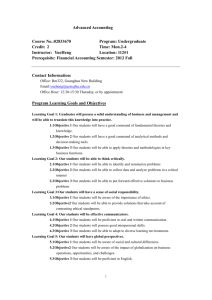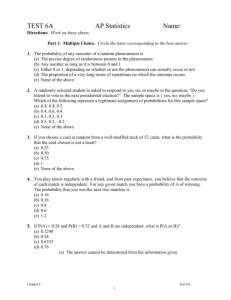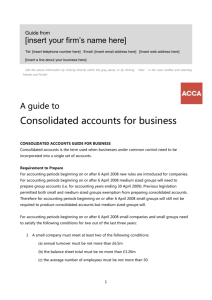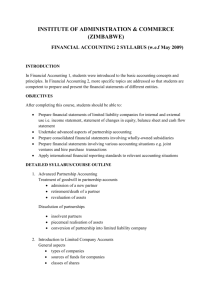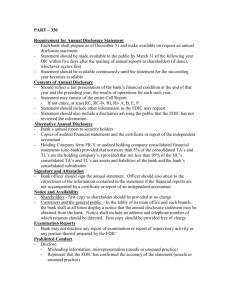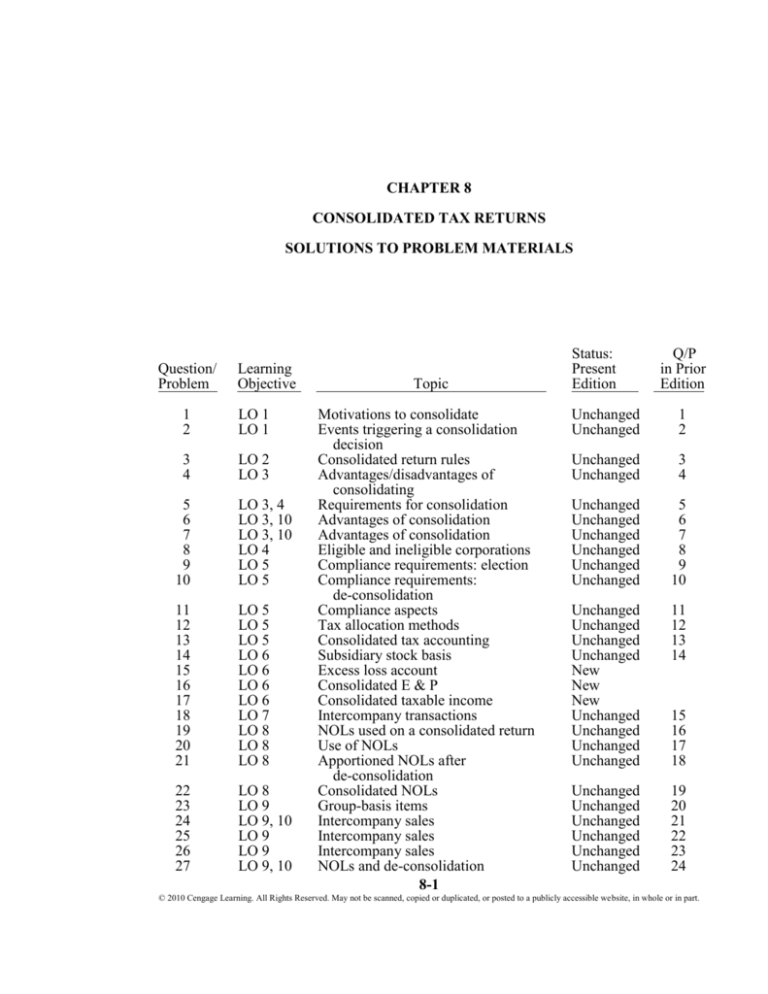
CHAPTER 8
CONSOLIDATED TAX RETURNS
SOLUTIONS TO PROBLEM MATERIALS
Question/
Problem
Learning
Objective
1
2
LO 1
LO 1
3
4
LO 2
LO 3
5
6
7
8
9
10
LO 3, 4
LO 3, 10
LO 3, 10
LO 4
LO 5
LO 5
11
12
13
14
15
16
17
18
19
20
21
LO 5
LO 5
LO 5
LO 6
LO 6
LO 6
LO 6
LO 7
LO 8
LO 8
LO 8
22
23
24
25
26
27
LO 8
LO 9
LO 9, 10
LO 9
LO 9
LO 9, 10
Topic
Motivations to consolidate
Events triggering a consolidation
decision
Consolidated return rules
Advantages/disadvantages of
consolidating
Requirements for consolidation
Advantages of consolidation
Advantages of consolidation
Eligible and ineligible corporations
Compliance requirements: election
Compliance requirements:
de-consolidation
Compliance aspects
Tax allocation methods
Consolidated tax accounting
Subsidiary stock basis
Excess loss account
Consolidated E & P
Consolidated taxable income
Intercompany transactions
NOLs used on a consolidated return
Use of NOLs
Apportioned NOLs after
de-consolidation
Consolidated NOLs
Group-basis items
Intercompany sales
Intercompany sales
Intercompany sales
NOLs and de-consolidation
8-1
Status:
Present
Edition
Q/P
in Prior
Edition
Unchanged
Unchanged
1
2
Unchanged
Unchanged
3
4
Unchanged
Unchanged
Unchanged
Unchanged
Unchanged
Unchanged
5
6
7
8
9
10
Unchanged
Unchanged
Unchanged
Unchanged
New
New
New
Unchanged
Unchanged
Unchanged
Unchanged
11
12
13
14
Unchanged
Unchanged
Unchanged
Unchanged
Unchanged
Unchanged
19
20
21
22
23
24
15
16
17
18
© 2010 Cengage Learning. All Rights Reserved. May not be scanned, copied or duplicated, or posted to a publicly accessible website, in whole or in part.
8-2
2010 Corporations Volume/Solutions Manual
28
*29
LO 10
LO 2
Choosing not to file consolidated
Unchanged
Intercompany transactions: tax versus book Unchanged
Instructor: For difficulty, timing, and assessment information about each item,
see p. 8-3.
Status:
Question/ Learning
Present
Problem
Objective
Topic
Edition
30
31
*32
*33
34
35
*36
*37
*38
LO 3, 9
LO 3, 5
LO 3
LO 4
LO 5
LO 5
LO 5
LO 5
LO 5
*39
40
*41
42
43
44
*45
LO 6
LO 7
LO 7, 8
LO 8
LO 8
LO 8
LO 9
Consolidated group partners
Consolidated group partners
Tax effects of affiliated group
Eligibility to consolidate
Tax liabilities of controlled group
Consolidated estimated taxes
Tax-sharing agreements
Tax-sharing agreements
AMT effects, separate and group basis
computation
Stock basis
Consolidated taxable income
Consolidated taxable income
NOLS and de-consolidation
SRLY and the § 382 overlap rule
SRLY limitations
Matching rule
25
26
Q/P
in Prior
Edition
Unchanged
New
Unchanged
Unchanged
Unchanged
Unchanged
Modified
Modified
Unchanged
27
Unchanged
Modified
Modified
Unchanged
Unchanged
Unchanged
Unchanged
35
36
37
38
39
40
41
28
29
30
31
33
34
32
*The solution to this problem is available on a transparency
master.
Instructor: For difficulty, timing, and assessment information about each item,
see p. 8-3.
Research
Problem
1
2
3
4
5
6
7
8
9
10
Topic
Affiliated group
De-consolidation of a consolidated group
Extending consent period
Consolidated group’s tax year
Internet activity
Internet activity
Internet activity
Internet activity
Internet activity
Internet activity
Status:
Present
Edition
Unchanged
Unchanged
Unchanged
New
Modified
Unchanged
Unchanged
Unchanged
Unchanged
Unchanged
Q/P
in Prior
Edition
1
2
3
4
5
6
7
8
9
© 2010 Cengage Learning. All Rights Reserved. May not be scanned, copied or duplicated, or posted to a publicly accessible website, in whole or in part.
Consolidated Tax Returns
Question/
Problem
Difficulty
Est'd
completion
time
Assessment Information
AICPA*
AACSB*
Core Comp
Core Comp
1
2
3
4
Easy
Medium
Easy
Medium
5
10
5
15
5
6
7
8
9
10
11
12
13
14
Easy
Medium
Medium
Easy
Easy
Easy
Medium
Easy
Medium
Medium
10
15
15
10
5
5
10
5
10
10
15
Medium
10
16
17
18
Easy
Easy
Medium
5
10
10
19
Easy
20
21
22
23
Medium
Easy
Easy
Medium
10
5
5
10
FN-Reporting
FN-Reporting
FN-Measurement
FN-Measurement | FNReporting
FN-Reporting
FN-Reporting
FN-Reporting
FN-Reporting
FN-Reporting
FN-Reporting
FN-Reporting
FN-Reporting
FN-Reporting
FN-Measurement | FNReporting
FN-Measurement | FNReporting
FN-Reporting
FN-Reporting
FN-Measurement | FNReporting
FN-Measurement | FNReporting
FN-Reporting
FN-Reporting
FN-Reporting
FN-Reporting
24
Medium
10
FN-Reporting
25
Easy
5
26
Easy
5
27
Hard
15
28
29
Easy
Medium
5
10
30
Medium
10
31
Medium
10
5
8-3
FN-Measurement | FNReporting
FN-Measurement | FNReporting
FN-Reporting
FN-Reporting
FN-Measurement | FNReporting
FN-Measurement | FNReporting
FN-Reporting
Analytic
Analytic
Analytic
Communication |
Analytic
Analytic
Analytic
Analytic
Analytic
Analytic
Analytic
Analytic
Analytic
Analytic
Communication |
Analytic
Analytic
Analytic
Analytic
Analytic | Reflective
Thinking
Analytic | Reflective
Thinking
Analytic
Analytic
Analytic
Communication |
Analytic
Analytic | Reflective
Thinking
Analytic
Analytic
Communication |
Analytic
Analytic
Analytic
Analytic | Reflective
Thinking
Analytic | Reflective
Thinking
© 2010 Cengage Learning. All Rights Reserved. May not be scanned, copied or duplicated, or posted to a publicly accessible website, in whole or in part.
8-4
2010 Corporations Volume/Solutions Manual
Question/
Problem
Est'd
completion
time
Difficulty
32
Medium
10
33
Medium
10
Assessment Information
AICPA*
AACSB*
Core Comp
Core Comp
FN-Measurement | FNReporting
FN-Reporting
Analytic
Analytic
*Instructor: See the Introduction to this supplement for a discussion of using AICPA and
AACSB core competencies in assessment.
34
Easy
5
35
Medium
10
36
Medium
10
37
Medium
10
38
Hard
15
39
Medium
10
40
Medium
10
41
Medium
10
42
Easy
5
43
Easy
5
44
Easy
5
45
Medium
10
FN-Measurement | FNReporting
FN-Measurement | FNReporting
FN-Measurement | FNReporting
FN-Measurement | FNReporting
FN-Measurement | FNReporting
FN-Measurement | FNReporting
FN-Measurement | FNReporting
FN-Measurement | FNReporting
FN-Measurement | FNReporting
FN-Measurement | FNReporting
FN-Measurement | FNReporting
FN-Measurement | FNReporting
Analytic
Analytic
Analytic
Analytic
Analytic
Analytic
Analytic
Analytic
Analytic
Analytic
Analytic
Analytic
*Instructor: See the Introduction to this supplement for a discussion of using AICPA and
AACSB core competencies in assessment.
© 2010 Cengage Learning. All Rights Reserved. May not be scanned, copied or duplicated, or posted to a publicly accessible website, in whole or in part.
Consolidated Tax Returns
8-5
CHECK FIGURES
29.b.
29.c.
32.a.
32.c.
32.f.
33.c.
34.
35.
36.
37.
LittleCo, no effect.
Big, $50,000 gain.
Separate, $1 million DRD is
allowed.
Consolidated, Giant and
PebbleCo are both fully liable for
$140,000 of tax.
Consolidated, the members can
retain their differing tax
accounting methods.
Controlled group, not affiliated.
Senior is liable for $2.5 million.
Parent remits $950 for 2011.
$241 allocated to Parent.
$269 allocated to Parent.
38.
39.a.
39.c.
40.
41.
42.
43.
44.
45.a.
45.b.
Consolidation reduces group
liability $37,500.
$31 million, end of 2009.
$25 million ELA, end of 2009.
$50,000 for 2010.
2008 $300,000; 2009 $90,000.
$1 million NOL carryforward.
$400,000.
NOL deduction in 2009 =
$500,000.
Consolidated taxable income
$110,000.
Consolidated taxable income
$210,000.
© 2010 Cengage Learning. All Rights Reserved. May not be scanned, copied or duplicated, or posted to a publicly accessible website, in whole or in part.
8-6
2010 Corporations Volume/Solutions Manual
DISCUSSION QUESTIONS
1.
One can find in the marketplace various motivations to consolidate corporate
holdings in such a way that a consolidated return is attractive.
The isolation of the assets of one corporation for the liabilities of another.
The execution of estate planning objectives.
A perceived value of retaining the separate identities of the acquired
corporation.
A need to shield the identities of a subsidiary’s true owners from the public.
A desire to optimize negotiations with labor unions, suppliers, or
governmental units.
pp. 8-2 and 8-3
2.
A consolidation election may be available as a result of various business
decisions.
A merger, acquisition, or other corporate combination.
A structural change in the capital of a corporation due to regulatory
requirements, competitive pressures, or economizing of operations.
A desire to gain tax or other financial advantages.
pp. 8-3 and 8-4
3.
Delegation of tax-writing authority to the Treasury may be a necessary evil in the
realm of the consolidated return. The length and detail of the rules associated with
consolidated returns makes them poorly suited for placement in the Code.
Moreover, as corporate structures and transactions become more complex every
year, the expertise that Treasury staffers and the tax professionals that they use to
draft the Regulations is critical. As long as the public review process for the
consolidated return Regulations remains thorough, the current situation may be
the best solution possible. p. 8-5
4.
SPEECH OUTLINE
November 3, 2009
WHEN TO USE CONSOLIDATED RETURNS
Potential Advantages of Filing Consolidated Returns
Use the operating and capital loss carryovers of one group member to shelter
the corresponding income of other group members.
Eliminate taxation of all intercompany dividends.
© 2010 Cengage Learning. All Rights Reserved. May not be scanned, copied or duplicated, or posted to a publicly accessible website, in whole or in part.
Consolidated Tax Returns
8-7
Defer recognition of income from certain intercompany transactions.
Optimize certain deductions and credits, by using consolidated amounts in
computing pertinent limitations.
Increase the tax basis of investments in the stock of subsidiaries by the
amount of positive subsidiary taxable income.
The domestic production activities deduction (§ 199) of a group might be
greater than the sum of the deductions for all of the affiliates, as the formula
for the deduction is optimized under the statute.
Use the alternative minimum tax (AMT) attributes of all group members in
deriving consolidated alternative minimum taxable income (AMTI), thereby
reducing the magnitude of the adjustment for adjusted current earnings (ACE)
and of other AMT preferences and adjustments.
Use the current-year operating losses of one group member to defer or reduce
the (regular or AMT) estimated tax payments of the entire group.
Potential Disadvantages of Filing Consolidated Returns
Binding nature of the election on all subsequent tax years of the group
members, unless either the makeup of the affiliated group changes, or the IRS
consents to a ‘‘de-consolidation.”
Apply the capital and operating losses of one group member against the
corresponding income of the other group members when assignment of such
losses to separate return years would produce a greater tax reduction
therefrom.
Defer recognition of losses from certain intercompany transactions.
Decrease the amounts of certain deductions and credits, by using consolidated
amounts in computing pertinent limitations.
Decrease the tax basis of investments in the stock of subsidiaries by the
amount of negative subsidiary taxable income, and by distributions therefrom.
Creation of short taxable years of subsidiaries, in meeting the requirement that
all group members use the parent’s tax year, thereby bunching income and
expending one of the years of the subsidiary’s charitable contribution and loss
carryforward period.
Recognition of legal and other rights of minority shareholders in the context
of a consolidated group.
Incurring of additional administrative costs in complying with the
consolidated return regulations.
pp. 8-6, 8-7, and Concept Summary 8.1
© 2010 Cengage Learning. All Rights Reserved. May not be scanned, copied or duplicated, or posted to a publicly accessible website, in whole or in part.
8-8
5.
2010 Corporations Volume/Solutions Manual
Before a consolidation election can be made under the tax law, three major
requirements first must be met.
Affiliated group status
Eligible corporation to file consolidated Statutory definitions
Compliance requirements
Stock ownership tests
Identifiable parent corporation
Forms 851, 1122
Conformity to parent’s tax year
pp. 8-8, 8-12, 8-13, and Concept Summary 8.1
6.
Pertinent tax issues include the following.
How accurate are the income and loss projections of the group members?
Will Black’s NOLs be available for deduction against future group taxable
income?
Will Black’s NOLs be available for immediate carryback, producing a tax
refund in the near future?
Will Red produce net taxable income at levels that will accelerate the use of
Black’s NOLs?
Will Red begin to produce new NOLs in the future?
Will Red’s new NOLs be deductible against group taxable income ?
pp. 8-6 and 8-7
7.
Additional pertinent tax issues include the following.
How will the group charitable contribution deduction be computed in the
future?
Will all of Brown’s charitable gifts be deductible against group taxable
income (i.e., considering the 10% floor on a group basis)?
How will the group’s § 1231 gain or loss be computed in the future?
How will Brown’s realized gain and loss affect the group’s § 1231 netting and
computation in the future?
Example 6
8.
The U.S. Red Cross
The Mutual of Kansas Insurance Company
Tequila Telefono, an entity organized in El Salvador
The Boston Yankees Partnership
The Henry Pontiac Trust
© 2010 Cengage Learning. All Rights Reserved. May not be scanned, copied or duplicated, or posted to a publicly accessible website, in whole or in part.
Consolidated Tax Returns
8-9
pp. 8-12 and 8-13
9.
In most cases, the decision to consolidate must be made no later than the extended
due date of the parent’s return for the year. Here, that date is September 15, 2010.
p. 8-13
10.
Terminations must be applied for at least 90 days prior to the extended due date of
the consolidated return. Here, that date is June 15, 2010. pp. 8-13 and 8-14
11.
a.
The first consolidated tax return for Lavender and Azure is due. Forms
851 and 1122 are attached.
b.
Separate company estimated payments are still allowed as the third year
has not yet been reached.
c.
The results of Rose’s tax year are included in the group return. The Form
851 now includes Rose, but no additional Form 1122 need be filed.
d.
The first date upon which an election to re-form the Lavender Azure and
Rose group would be allowed, lacking IRS permission. This is after five
tax years pass since Rose left the group.
Filing dates can be extended, or Rose might not elect immediately to be included
in the group. The two-year rule for estimated taxes cannot be extended by
taxpayer election, and it is difficult to get the IRS to shorten the five-year waiting
period.
pp. 8-13 and 8-14
12.
Under the relative taxable income method, the consolidated tax liability is
allocated among the members based on their amounts of separate taxable income.
When the relative tax liability method is used, the allocation is based on the
hypothetical separate tax liabilities of the affiliates. Example 16
13.
Members of a consolidated group must use the same tax year-end, but they can
retain differing accounting methods. The $5 million gross-receipts test is applied
on a group basis, so Child may be forced to switch to the accrual basis of
accounting. However, personal service corporations can elect to avoid such a
switch. If Child is found to be in such an industry and the cash method remains
desirable, this election may be attractive. But the list in § 448(d)(2)(A) seems to
preclude the group from making the election to keep Child’s cash basis method.
pp. 8-16, 8-17, and Table 8.1
14.
TAX FILE MEMORANDUM
November 3, 2009
To:
Tax File
From: Stephanie Brewer
© 2010 Cengage Learning. All Rights Reserved. May not be scanned, copied or duplicated, or posted to a publicly accessible website, in whole or in part.
8-10
2010 Corporations Volume/Solutions Manual
Re:
Adjustments to subsidiary stock basis
Positive Adjustments
Consolidated taxable income
Unused operating or capital loss
Negative Adjustments
Consolidated taxable loss
Operating and capital losses, used or carried back this year, if not previously
deducted from basis
Dividends paid to parent out of E & P
p. 8-17
15.
A parent’s stock basis in a consolidated subsidiary never can go below zero. But
when negative adjustments exceed the stock basis in the subsidiary, an excess loss
account is created, in the amount of the negative adjustments. This means that
annual operating and other losses of the subsidiary can continue to be deducted on
the consolidated return; their use is not suspended as would be the case with
partnerships and S corporations (see Chapters 10 and 12, respectively).
If the subsidiary stock is sold or redeemed by the parent when an excess loss
account exists, the parent typically recognizes the balance of the account as
capital gain.
p. 8-18
16.
There is no such concept as consolidated earnings and profits (E & P). The
subsidiaries keep track of their respective E & P balances on a pre-consolidated
basis, as does the parent. A subsidiary’s E & P records its own operating results,
and it makes E & P adjustments for its agreed-upon share of the consolidated
Federal income tax liability. E & P of the subsidiary also reflects any gain/loss on
intercompany transactions with other affiliates. p. 8-18
17.
Consolidated taxable income is derived using the following step-wise
computational method.
Compute taxable income for each affiliate on a separate basis, applying the
usual rules of Subchapter C and the rest of the Code.
Remove from each affiliate’s separate taxable income any group items.
Remove from each affiliate’s separate taxable income the tax effects of any
intercompany transactions.
Account for any intercompany distributions and permanent eliminations from
consolidated taxable income.
© 2010 Cengage Learning. All Rights Reserved. May not be scanned, copied or duplicated, or posted to a publicly accessible website, in whole or in part.
Consolidated Tax Returns
8-11
Use the combined amounts from all affiliates to compute the effects on
consolidated taxable income of each of the identified group items. Add these
positive or negative amounts back to taxable income (or the amount of the
AMT base).
Isolate the effects of intercompany transactions on consolidated taxable
income.
Combine all of the pertinent amounts into consolidated taxable income.
p. 8-18 and Figure 8.1
18.
Parent is attempting to mismatch its own 2009 recognition of gross income from
the service contract with a 2010 deduction by Child. Parent’s own NOL situation
for the year makes attractive such a net income acceleration for the group.
Unfortunately for the group, §§ 267(a)(2) and (b)(3) force a matching of the two
events. The deduction is claimed in the year of gross income recognition (here,
2009), and the net result to the group is an addition to consolidated taxable
income of zero.
p. 8-20
19.
Perhaps not. At most, only $1,500,000 of SubOne’s NOL carryforward can be
used in the first tax year, which is that entity’s cumulative contribution to
consolidated taxable income. Then, § 382 may reduce that deduction. Figure 8-3
20.
Under the so-called offspring rule, a consolidated group can carry back a loss that
is apportioned to a group member that did not exist in the carryback year, where
the new corporation’s existence is rooted in the parent’s assets (e.g., due to a
divisive reorganization similar to that which created Junior). If the member joined
the group immediately upon its incorporation, the group can use the loss. Reg.
§1.1502-79(a)(2)
Thus, if Junior consents to join the consolidated group, its $500,000 apportioned
NOL is available for carryback and can create a refund for the group. If Junior
does not join the group this year, the SRLY rules will restrict the use of the NOL
to carryforwards related to the income contributions of Junior to the group after
its consent is received. Example 26
21.
When a member leaves a consolidated return group, it takes with it the net
operating loss carryforwards that are apportioned to it. Thus, assuming that § 382
limitations do not restrict the deduction, White will report a zero taxable income
on its first two separate Forms 1120, and $100,000 on the third. The NOL
carryforwards apportioned to Beige remain with the parent and any newly formed
consolidated group. Example 27
22.
The separate return limitation year (SRLY) rules defer the deduction for the net
operating losses of an affiliate until that corporation contributes positively to
consolidated taxable income. The SRLY rules are intended to prevent an offset
against an existing group’s taxable income by using current loss deductions that
are traceable to an affiliate’s operations prior to its joining the consolidated group.
© 2010 Cengage Learning. All Rights Reserved. May not be scanned, copied or duplicated, or posted to a publicly accessible website, in whole or in part.
8-12
2010 Corporations Volume/Solutions Manual
The new affiliate’s NOLs are allowed, but only after that affiliate makes positive
contributions to the taxable income of the group.
SRLY rules are overridden to the extent that there is a § 382 limitation on NOL
deductions for the group (see Chapter 7).
pp. 8-25 and 8-26
23.
A consolidated group computes the following items on a group basis when filing
its tax return.
Net capital gain/loss
§ 1231 gain/loss
§ 199 domestic production activities deduction
Casualty/theft gain/loss
Charitable contributions
Dividends received deduction
Net operating loss
Various credits and their recapture
Percentage depletion deduction
AMT exemption, preferences, and adjustments
pp. 8-26 and 8-27
24.
a.
The matching rule generally defers gain/loss recognition until an asset is
sold outside of the consolidated group. The matching rule applies a ‘‘one
company with multiple divisions” approach to intercompany transactions.
The acceleration rule applies when the matching rule is inappropriate,
triggering immediate recognition of the gain/loss.
b.
Most taxpayers prefer to apply the matching rule to gains and the
acceleration rule to losses.
pp. 8-29 and 8-30
25.
The only reflection of these transactions in consolidated taxable income is in Year
4, when the total $60 gain is recognized. The matching rule defers the Year 3
realized gain, as though it were a sale between divisions of one corporation.
Example 34
26.
The only reflection of these transactions in consolidated taxable income is in Year
4, when the total $60 loss is recognized. The matching rule defers the Year 3
realized loss, as though it were a sale between divisions of one corporation. The
© 2010 Cengage Learning. All Rights Reserved. May not be scanned, copied or duplicated, or posted to a publicly accessible website, in whole or in part.
Consolidated Tax Returns
8-13
matching rule is designed to prevent group members from accelerating loss
deductions that are realized within the group. Example 34
27.
TAX FILE MEMORANDUM
August 4, 2009
To:
File—Pro-Junior version
Re:
Client Junior’s Deferred Loss
Facts
When Junior left the Rice consolidated group, it left behind a
$600,000 deferred loss from intercompany sales.
Issue
Can Junior take the loss with it and use it on subsequent separate
returns?
Conclusion
Junior may have a claim to the loss if ownership levels change
such that it no longer is a member of the Rice controlled group.
Reasoning
Deferred losses remain with the group when the corporation that
generated the loss leaves the group, if the departing member
remains part of the electing entities’ controlled group [§ 267(f)]. It
is unlikely that the group will allow Junior to take the loss without
some offsetting compensation.
TAX FILE MEMORANDUM
August 4, 2009
To:
File—Pro-Rice version
Re:
Client Junior’s Deferred Loss
Facts
When Junior left the Rice consolidated group, it left behind a
$600,000 deferred loss from intercompany sales.
Issue
Can Junior take the loss with it and use it on subsequent separate
returns?
Conclusion
The loss remains with the group, because Junior is still a member
of the Rice controlled group and § 267(f) prohibits the related
party loss deduction, even after Junior leaves the electing
consolidated group.
Reasoning
The asset still is held by the group, and gain recognition is
controlled by whether the asset leaves the group’s ownership.
pp. 8-29 and 8-30
28.
A parent might prefer to avoid the consolidation election when:
An affiliate is organized outside the U.S.
© 2010 Cengage Learning. All Rights Reserved. May not be scanned, copied or duplicated, or posted to a publicly accessible website, in whole or in part.
8-14
2010 Corporations Volume/Solutions Manual
An affiliate is an insurance company.
An affiliate brings undesired tax attributes to the group, like a sizable balance
in its E & P.
There is a greater tax benefit in merely claiming a dividends received
deduction for payments among group members.
Compliance and administrative costs associated with the consolidated return
election are excessive.
p. 8-31
PROBLEMS
29.
Tax and book treatment of intercompany transactions are similar but not identical.
Example 5
Transaction
Little pays a dividend to
Big
Book Treatment
Consolidated
eliminating entry — No
effect on book income
Little sells an asset at a No effect
gain to Big
Big
sells
the Big reports $150,000
intercompany- sale asset gain
to an outsider
30.
Consolidated Tax Return
Treatment
Consolidated eliminating
entry — No effect on
taxable income
No effect
LittleCo recognizes
$100,000 gain. Big
recognizes $50,000 gain.
Finding good consolidated return partners often means that contrary tax effects
are matched together, resulting in a lower total Federal income tax. Example 6
a.
Probably a good match. Intercompany gains are deferred until a sale is
made to a taxpayer outside of the consolidated group.
b.
Probably not a good match. The parties want to accelerate recognition of
the realized losses, and consolidation results in the deferral of those losses.
c.
Probably a good match, depending on the current marginal tax rates of the
group members. If consolidation occurs, ShortCo’s foreign-source income
could be used to free up the foreign tax credit carryforwards, resulting in
immediate tax reductions.
d.
Probably not a good match. An attractive consolidated return partner
would allow ParentCo to shelter some of its Federal taxable income, and
Small will produce such losses for only one tax year. Moreover, after a deconsolidation, the group probably could not re-elect to form a group again
for five tax years, so planning flexibility would be lost.
© 2010 Cengage Learning. All Rights Reserved. May not be scanned, copied or duplicated, or posted to a publicly accessible website, in whole or in part.
Consolidated Tax Returns
31.
32.
8-15
Finding good consolidated return partners often, but not always, means that
contrary tax effects are matched together, resulting in a lower total Federal
income tax. Example 6
a.
Probably a good match, especially if the affiliated group’s domestic
production activities deduction (DPAD) is greater than the sum of Parent’s
and SubCo’s DPAD.
b.
Perhaps not a good match. The election to consolidate cannot be “turned
on and off.” The election is binding on all future tax years, and this may
not be a desirable result if both affiliates generate a positive taxable
income. If an election is made and approved to “de-consolidate,” the same
group cannot re-elect consolidated status for five years.
c.
Probably not a good match. Tax return elections made by the parent of a
consolidated group are binding on all members of the filing group for the
tax year.
d.
Probably not a good match. SubTwo must convert to a calendar tax year
upon joining the ParentCo consolidated group, and this may result for the
group in a bunching of more than twelve months of taxable income into
the calendar year of the election.
When an affiliated group exists, Federal income tax treatment often changes for
the group members. Table 8.1
Item
If Consolidated Return Is Filed
If Separate Returns Are Filed
a.
The payment is eliminated in
dividend computing consolidated
taxable income, so no tax.
Only one 15% tax bracket is allowed
to the affiliated group, so total
Federal income tax is $22,250. An
allocation method is used to
determine the payment of each
member.
Both corporations are fully liable for
the $140,000 tax liability. An
allocation method is used to
determine the payment of each
member.
Only one $250,000 floor is allowed
to the affiliated group in computing
the accumulated earnings credit. The
parties are not allowed two such
floors.
Giant reports $1 million in income,
then claims a $1 million dividends
received deduction.
Only one 15% tax bracket is
allowed to the controlled group, so
total Federal income tax is $22,250.
b.
c.
d.
Giant is liable only for its $65,000
liability, and PebbleCo for its
$75,000.
Only one $250,000 floor is allowed
to the controlled group in
computing
the
accumulated
earnings credit. The parties are not
allowed two such floors
© 2010 Cengage Learning. All Rights Reserved. May not be scanned, copied or duplicated, or posted to a publicly accessible website, in whole or in part.
8-16
33.
2010 Corporations Volume/Solutions Manual
Item
If Consolidated Return Is Filed
If Separate Returns Are Filed
e.
PebbleCo must convert to a calendar PebbleCo can retain its fiscal tax
tax year, immediately upon joining year.
the Giant consolidated group.
f.
The affiliates can continue to use
different inventory tax accounting
methods.
The affiliates can continue to use
different inventory tax accounting
methods.
The 80% test is failed in a. In b., stock attribution rules apply in identifying a
controlled group, but not an affiliated group. In c., the affiliated group test must
be met on every day of the tax year, while the controlled group test must be met
only on the last day of the year. pp. 8-9, 8-10, and 8-12
Situation
a.
b.
c.
Facts
Parent-Subsidiary
Controlled
Group? (Y/N)
Affiliated
Group?
(Y/N)
N
N
Y
N
Y
N
Throughout the year, P
owns 65% of the stock of S.
Parent owns 70% of SubCo.
The other 30% of SubCo
stock is owned by Senior, a
wholly owned subsidiary of
Parent.
For 11 months, P owns 75%
of the stock of S. For the
last month of the tax year, P
owns 100% of the S stock.
34.
Senior must pay the $2.5 million for Junior’s Federal Income taxes, as
consolidated return partners have joint and several liability as to taxes due. The
bankruptcy receiver will determine the ultimate disposition of the $1 million
owed to the supplier, but Senior is not likely to have any responsibility for paying
that obligation. p. 8-14
35.
Consolidated tax estimates are not required of the group until its third tax year
under the election. Lacking an agreement to the contrary, Sub makes its own
estimates for 2008 and 2009. p. 8-14
Year
2008
2009
2010
2011
Parent Remits
$500
$500
$900
$950
Sub Remits
$220
$200
$0
$0
© 2010 Cengage Learning. All Rights Reserved. May not be scanned, copied or duplicated, or posted to a publicly accessible website, in whole or in part.
Consolidated Tax Returns
36.
8-17
Consolidated tax liabilities are shared in the following manner.
Separate Taxable Allocation Ratio Allocated Tax Due
Income
Parent
SubOne
SubTwo
SubThree
Totals
$ 850
300
50
–0–
$1,200
850/1,200
300/1,200
50/1,200
0
$241
85
14
–0–
$340
Example 16
37.
Consolidated tax liabilities are shared in the following manner.
Separate
Taxable
Income
Parent
SubOne
SubTwo
SubThree
Totals
$ 850
300
50
–0–
$1,200
Separate Tax
Liability
Allocation
Ratio
Allocated
Tax Due
$297.5
65, after
applying energy
tax credit
17.5
–0–
$380.00
297.5/380
$266
65/380
58
17.5/380
0
16
–0–
$340
Example 16
38.
ACE Adjustment = .75(ACE – Pre-ACE AMTI)
Without consolidation
As consolidated
ParentCo
DaughterCo
Group
.75($700,000) = $525,000
$0 [Negative $187,500 adjustment is
wasted]
$525,000
Group
.75($450,000) = $337,500
The unused “negative” ACE adjustment of $187,500 generated by DaughterCo is
used by the group when a consolidation election is in force.
AMT Exemption
The affiliates share one exemption, but because of the phaseout percentages, the
exemption becomes zero whether or not a consolidation election is made.
Thus, the election to consolidate benefits the group overall by reducing the group
liability by $37,500 ($187,500 reduction in aggregate ACE adjustment × 20%
AMT), in a manner traceable to the computation of the ACE adjustment.
p. 8-16 and Chapter 3
© 2010 Cengage Learning. All Rights Reserved. May not be scanned, copied or duplicated, or posted to a publicly accessible website, in whole or in part.
8-18
339.
2010 Corporations Volume/Solutions Manual
Stock Basis at
End of Year
Alternative A
Alternative B
2008
2009
$34 million
$41 million
$34 million
$19 million
2010
$51 million
$29 million
Alternative C
$34 million
$15 million Excess Loss
Account
$5 million Excess Loss
Account
If a subsidiary is sold while its parent holds an Excess Loss Account in it, capital
gain income is created to the extent of the account balance.
Examples 18 and 19
40.
Consolidated taxable income is computed as follows.
2008
$200,000
2009
170,000
2010
50,000
2011
340,000
The Orange losses offset the Teal income dollar for dollar, but they never become
large enough to produce a consolidated loss. Because both corporations produce
ordinary income, there are no adjustments to make using the format of Figure 8.2.
There are no consolidated NOL carryovers in any of the specified years.
Example 21
41.
It is assumed that the group does not elect to forgo the carryback of the 2010
consolidated net operating loss.
Consolidated taxable income
2008
$300,000
2009
90,000
2010
0
2011
($350,000) NOL carryback. This first generates a full refund
of the 2008 group tax liability. The remaining $50,000 NOL
carryback then generates a partial refund of the 2009 group
income tax liability. The 2010 NOL now is fully used.
325,000
Example 23
42.
In years when a group member files a separate return (e.g., due to a deconsolidation of the member from the group), each member can carry over only
its apportioned segment of the group NOL. Thus, Ocelot can use its $1 million
share of the group NOL carryforward on its 2009 separate return. Figure 8.3
© 2010 Cengage Learning. All Rights Reserved. May not be scanned, copied or duplicated, or posted to a publicly accessible website, in whole or in part.
Consolidated Tax Returns
8-19
43.
The NOL deduction is limited to $400,000, the annual § 382 amount. The § 382
provisions prevail over those of the SRLY rules when both restrictions apply.
Example 30 and Chapter 7
44.
Under the SRLY rules, the group cannot carry back the losses that Child brings
into the group. Subsequent deductions are limited to the cumulative positive
contributions toward group taxable income that are traceable to Child. Child’s
NOL can be deducted by the Thrust group as follows.
2008. . . . . . $0
(exhausted)
2009. . . . . . $500,000
2010. . . . . . $400,000
Figure 8-3
45.
a.
This intercompany transaction is subject to the matching rule. Realized
gain is deferred, through an elimination in the computation of consolidated
taxable income. The $80,000 gain is recognized when SubCo later sells
the land to Outsider.
Separate
Taxable Income
ParentCo
$210,000
Information
SubCo Information
Group-Basis
Transactions
Intercompany
Events
Consolidated
Taxable Income
NOTES
† Matching Rule
Adjustments
PostAdjustment
Amounts
$210,000
($ 20,000)
($ 20,000)
– $80,000 Gain on
intercompany sale
to SubCo †
($ 80,000)
$110,000
© 2010 Cengage Learning. All Rights Reserved. May not be scanned, copied or duplicated, or posted to a publicly accessible website, in whole or in part.
8-20
2010 Corporations Volume/Solutions Manual
b.
The solution includes the $10,000 post-acquisition gain realized and
recognized by SubCo on the land.
Separate
Taxable
Income
ParentCo
Information
SubCo Information
Group-Basis
Transactions
Intercompany
Events
Consolidated
Taxable Income
Adjustments
Post-Adjustment
Amounts
$90,000
$ 90,000
$40,000
$ 40,000
– $80,000 Restore
gain on ParentCo’s
Sale to SubCo †
+ $ 80,000
$210,000
NOTES
† Matching Rule
Example 34
The answers to the Research Problems are incorporated into the Instructor’s Guide with
Lecture Notes to accompany the 2010 Annual Edition of SOUTH-WESTERN FEDERAL
TAXATION: CORPORATIONS, PARTNERSHIPS, ESTATES & TRUSTS.
© 2010 Cengage Learning. All Rights Reserved. May not be scanned, copied or duplicated, or posted to a publicly accessible website, in whole or in part.



